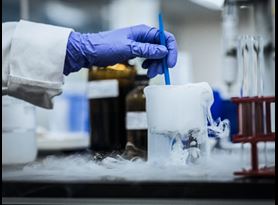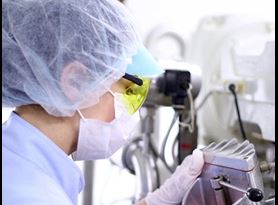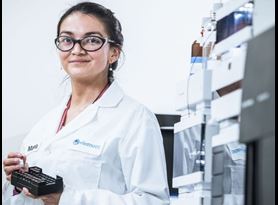Clinical Diagnostics: Development, Troubleshooting & Validation
Throughout the COVID-19 pandemic, much discussion has taken place, both in the media and amongst the scientific community, regarding diagnostic testing for the SARS-CoV-2 virus. Tackling a pandemic requires an "all hands-on deck" approach when it comes to the development and validation of new clinical diagnostic tests.
Accurate diagnosis of COVID-19 patients is critical to provide proper treatment and care, as well as to protect the public from further exposure to the virus, but it also serves to prevent the negative impact patients can experience when receiving "false positive" test results, given the highly stressful circumstances they are already experiencing. Furthermore, false positive results for diagnostic tests can lead to unnecessary quarantine measures, wasted contact tracing and testing resources, and a delay in an accurate diagnosis and appropriate treatment. Likewise, false negative results can lead to the lack of appropriate treatment for an individual who has been infected with SARS-CoV-2, as well as further spread of the disease. The US Food and Drug Administration (FDA) issued the Policy for Coronavirus Disease-2019 Tests During the Public Health Emergency on March 16, 2020, to guide clinical labs (CLIA labs), developers, and manufacturers in their efforts to make accurate and specific clinical diagnostic tools rapidly available. The guidance was subsequently updated in November 2021, and the guidance document can be accessed through the FDA’s website.
Categorization of clinical diagnostic tools
The FDA categorizes new clinical diagnostic tests into three groups based on “Principal Technology,” which includes:
- Molecular Diagnostics (tests for COVID-19 nucleic acid);
- Antigens (tests for viral particles), or
- Serological (tests for antibodies, i.e., IgM and IgG)
New diagnostic tests which are developed should be evaluated to ensure analytical and clinical validity for the following:
- Accuracy;
- Specificity, and
- Sensitivity.
The Agency’s Statistical Guidance on Reporting Results from Studies Evaluating Diagnostic Tests provides additional guidance for industry.
How Element supports the development, troubleshooting and validation of clinical diagnostics
Element is an independent cGMP/cGLP contract research and development organization supporting healthcare organizations and manufacturers who are engaged in the development, troubleshooting, and validation of diagnostic tools for COVID-19 and other diseases. We have a proven track record of helping clients address challenges that are commonly faced during diagnostic test development and validation, including:
Clinical accuracy
To validate tests, samples which have been verified to be COVID-19 positive need to be tested by orthogonal methods. Although there has been some difficulty sourcing and obtaining COVID-19 samples at times throughout the pandemic, Element has identified reliable sources from which to obtain samples for the purposes of analytical validation.
Cross-reactivity
Due to previous infection, cross-reactivity is extremely common, and therefore ought to be assessed during diagnostic method development and validation. As the COVID-19 pandemic continues, instances of cross-reactivity will be become more prevalent, due to an increasing number of previously infected individuals.
Interfering substances
Samples must be evaluated for potential interference by common substances which are frequently found in nasal swab or serum samples, including nasal sprays, anti-viral drugs, or the patient’s blood.
Specificity and sensitivity
To demonstrate and determine specificity and sensitivity, the prospective diagnostic tests must be screened with known positive SARS-CoV-2 samples to ensure coronavirus strains other than SARS-CoV-2, such as coronavirus HKU1, NL63, OC43, or 229E are not resulting in false positive or false negative results.
Impurity identification and troubleshooting
At times, impurities can confound test results, and the sources of these impurities can range from diagnostic test itself (i.e., the manufacturing process), or from the patient (i.e., the sample matrix). Element employs sensitive qualitative and quantitative biochemical and chemistry methods to identify interferences and guide further development, optimization, and refinement efforts. Additionally, tubes and materials used for the purposes of specimen and sample collection can be subject to instability, impacting the validity of test results over time. To address and avoid this issue, Element can develop stability indicating methods and perform stability studies to ensure the continued performance of diagnostic test kits over the expected life of the diagnostic.
Commonly used tools and techniques
Element’s scientists frequently use a wide range of analytical methodology and instrumentation when troubleshooting, developing, and validating clinical diagnostics, including:
- Liquid chromatography coupled with DAD, UV, ELSD, or MS Detection (purity of raw materials, constituents);
- Liquid chromatography coupled with an analytical fraction collector;
- Mass spectrometry (QToF, or MS/MS) (identification of contaminants and low-level constituents);
- Capillary electrophoresis (purity and characterization of biomolecules);
- Immunoassays;
- SDS-PAGE;
- Cell culture, and
- UV and fluorescence plate reader (high throughput assessment of biochemical assays).
Our consultative, knowledgeable team of scientists and regulatory experts are standing by to help you quickly bring your clinical diagnostic tests to market.
Find related Resources
Learn more

Product Development
Element's leading product development labs have a track record of success innovating, optimizing and formulating products for various industries and applications.

Analytical Method Development and Validation
Element provides innovative analytical method development and validation solutions to regulatory guidelines for a wide range of analytical technologies.

Chemistry, Manufacturing, and Controls (CMC) Consulting Services
We provide consulting services for Chemistry, Manufacturing, and Controls (CMC) product development in the pharmaceutical and biotechnological industries.
Sign Up for Free Resources
Visit Element's email subscription center to receive the latest industry news, technical whitepapers, case studies, webinars, and upcoming events.
